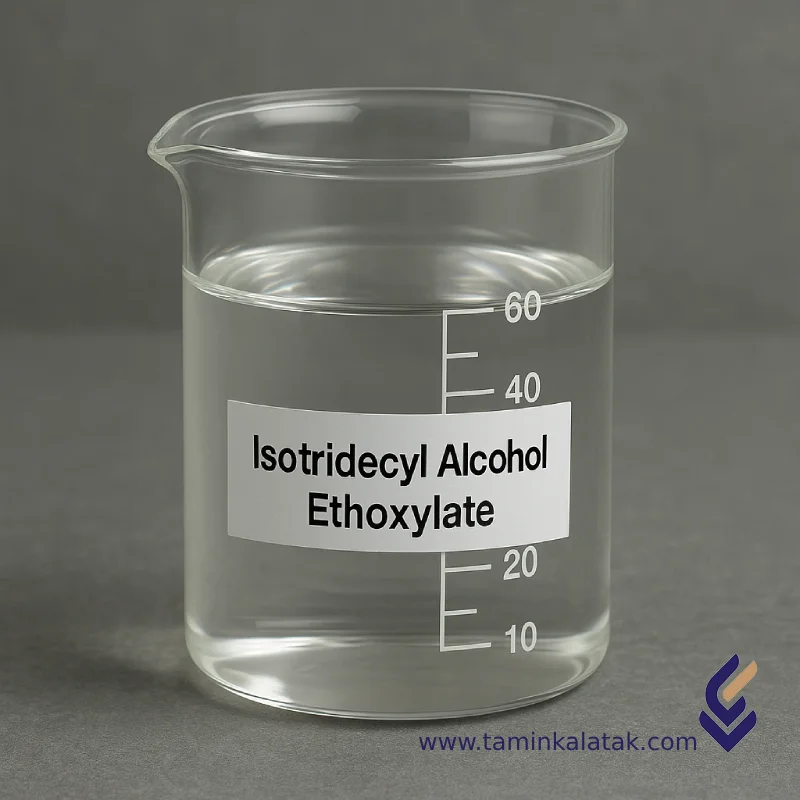Ethoxylated isotridecyl alcohol
Isotridecyl Alcohol Ethoxylate (ITDE) is a branched nonionic surfactant produced through the ethoxylation reaction of a branched-chain alcohol known as isotridecyl alcohol with ethylene oxide (EO). This compound functions as a surface-active agent, emulsifier, detergent, wetting agent, penetration enhancer, and dispersant in various industries. Owing to its excellent chemical stability and high performance in acidic, alkaline, and hard water environments, it is widely used in household and industrial cleaning formulations, as well as in textile and agricultural processes.
Chemical Structure of Isotridecyl Alcohol Ethoxylate
The molecule consists of a branched 13-carbon (C13) isotridecyl alcohol backbone, which is linked to multiple ethylene oxide (EO) units—typically between 3 and 12 moles, depending on the product grade.
It features two distinct segments:
-
Lipophilic (hydrophobic) part derived from the branched isotridecyl chain
-
Hydrophilic part derived from ethoxylate (EO) groups
This dual structure allows the compound to dissolve effectively in both aqueous and non-aqueous systems, exhibiting strong surface activity and excellent wetting and emulsifying properties.
Properties of Isotridecyl Alcohol Ethoxylate
-
Type: Nonionic surfactant
-
Solubility: Readily soluble in water, alcohols, and many organic solvents
-
Thermal and chemical stability: Excellent, especially within a pH range of 4–9
-
Foaming tendency: Moderate to low (depending on degree of ethoxylation)
-
Compatibility: Highly compatible with anionic, cationic, and amphoteric surfactants
-
Biodegradability: Good; meets OECD standards
-
Irritation potential: Low (in cosmetic-grade formulations suitable for personal care)
Applications of Isotridecyl Alcohol Ethoxylate
✔️ In detergent and cleaning formulations:
Used in dishwashing liquids, laundry detergents, shampoos, industrial hard-surface cleaners, and car wash products.
✔️ In textile processing:
Acts as a wetting, penetrating, and de-oiling agent during pretreatment and dyeing operations.
✔️ In leather, dyeing, and printing industries:
Serves as an emulsifier and emulsion stabilizer.
✔️ In agriculture:
Functions as a co-surfactant, wetting agent, and dispersant in pesticide and foliar fertilizer formulations, enhancing spreading and penetration on leaf surfaces.
✔️ In oil and gas industry:
Used in foam control systems, drilling fluids, degreasing, and phase separation processes.
✔️ In coatings, inks, and paints:
Improves pigment wetting, dispersion, and surface tension control in water-based systems.
Advantages of Isotridecyl Alcohol Ethoxylate
-
Excellent compatibility with both ionic and nonionic ingredients
-
Effective performance under both high and low temperature conditions
-
Safe for skin in personal care formulations
-
Enhances cleaning efficiency and reduces surface tension of solutions
-
Decreases phosphate demand in detergent systems
Disadvantages of Isotridecyl Alcohol Ethoxylate
❌ May exhibit low foaming in certain formulations and often requires blending with foaming surfactants (e.g., SLES)
❌ Higher cost compared to simple anionic surfactants
❌ Reduced stability under extreme pH conditions (below 3 or above 11)
❌ At high concentrations, may cause excessive degreasing (undesirable in skincare formulations)
Safety and Storage of Isotridecyl Alcohol Ethoxylate
Isotridecyl Alcohol Ethoxylate is one of the most commonly used nonionic surfactants in detergent, textile, and agricultural applications, and is classified as a low- to moderate-hazard substance in terms of safety. It is generally non-flammable, but direct contact with skin or eyes may cause mild irritation.
Safe Handling and Storage Recommendations:
-
Store in sealed, corrosion-resistant containers
-
Keep in a dry, cool, and well-ventilated area
-
Avoid freezing and exposure to high temperatures
-
Use protective gloves, safety goggles, and masks during handling
✅ Adhering to these safety guidelines helps maintain material stability and minimize potential hazards in the workplace.
Applications
| Applications | , , , |
|---|
Ethoxylated isotridecyl alcohol
| Products | Chemical formula | CAS number | Solubility in water | Grade | Melting point | Density (at 20°C) | Physical appearance | Vapor pressure |
|---|---|---|---|---|---|---|---|---|
| Isotridecyl Alcohol Ethoxylate | C₁₃H₂₇(OCH₂CH₂)ₙOH | 69011-36-5 | Completely soluble in water (depends on EO level, grades with higher EO are more soluble) | Industrial Grade, Detergent Grade, Textile Grade | Below 0°C (usually remains liquid at room temperature) | About 0.95 – 0.98 g/cm³ | Viscous (thick) liquid, clear to pale yellow | Very low, < 0.01 mmHg at 20°C |







